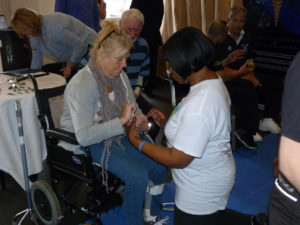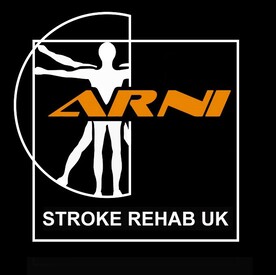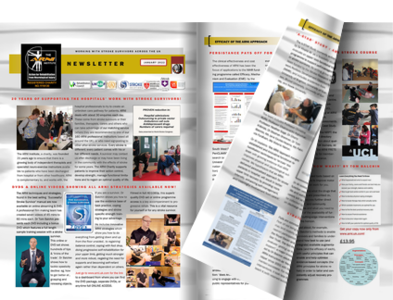Heidi Johansen-Berg is Professor of Cognitive Neuroscience and Director of The Wellcome Centre for Integrative Neuroimaging at the University of Oxford. There, she leads the Centre for Functional MRI of the Brain. Her research focuses on how the brain changes with learning, experience, and damage.
As well as shedding light on how the healthy brain responds to change, her team’s work also has implications for understanding and treating disease. For example, they are testing new methods for rehabilitation after stroke and assessing whether taking up exercise could slow the effects of age on the brain.
DO YOU HAVE DIFFICULTY USING YOUR HAND/ARM AFTER STROKE?
If so, Professor Johnsen Berg-has asked us to disseminate a study in which you may be interested in participating – or you may know someone who is.
 The aim for this study is to research a treatment method to see if can improve upper limb function.
The aim for this study is to research a treatment method to see if can improve upper limb function.
Many stroke survivors experience weakness to one side of the body, leaving them with difficulties in daily activities. Current physical therapies are limited in their success and are very time demanding. Therefore, treatments to use alongside rehabilitation are sought.
Learning is an important part of rehabilitation after stroke. When learning a new movement or skill it is important to get feedback so that you can repeat movements that were successful or try to adapt ones that did not work as well. What if there was a way to also get feedback of your brain activity when trying different movements?
Researchers at the University of Oxford are currently testing a new type of treatment for stroke survivors using MRI Neurofeedback. Neurofeedback involves participants being shown a live visual display of their brain activity whilst in an MRI scanner so that they can see which kinds of movements are best to increase the activity in the brain hemisphere where the stroke occurred.
Participants are asked to lie in the scanner and try to move their affected hand in different ways. The activity of their brain is recorded while they perform these movements and then shown to them as a ‘thermometer type’ bar that gets bigger with more activity.
Previous neurofeedback studies by Dr Heather Neyedli of the University of Oxford (Neyedli et al., Neuroscience, 2017) tried showing real or placebo feedback while volunteers who had not had a stroke moved their hands. They found that people could use this technique to change their brain activity while moving their hand.
There has been limited work with stroke survivors using this technique and researchers at Oxford are currently looking for people who have difficulty using their hand/arm after a stroke to take part in some MRI neurofeedback sessions to see if this treatment can improve motor function.
If you would like to join this study/find out more, please feel free to contact the researchers:
Mr Tom Smejka: thomas.smejka@ndcn.ox.ac.uk
Dr Melanie Fleming: melanie.fleming@ndcn.ox.ac.uk
Professor Heidi Johansen-Berg: heidi.johansen-berg@ndcn.ox.ac.uk
CALL 01865 611461
Example of visual display showing increasing brain activity

Below is a talk given by Professor Johansen-Berg – click and play!




4 Comments
I had a stroke 2 years ago since when I have had little movement in my left arm – my left leg is somewhat better and I am able to walk with a stick.
I would be interested in taking part in a trial if eligible.
Hi Ingrid I had a stroke 7 years ago completely out of the blue not overweight and I was fit. Discharged from hospital after a month. Had problems walking and using my left arm. Even now after a huge amount of time in the gym my left arm and leg are about 20% weaker.
But I still carry on trying to increase the strength in it and so must you. In the words of Churchill Never Never Never give in. Another real truism is Wether you think you can or you think you can’t your right.
Mr Balchin. I Have Your Book . I Found it most helpful. I am having problems with my arm and Hand. My Arm Has Gone Down away from my Neck on my right side. Where it had put it’s self After my Stroke. I was Riding My Horse When The Blood Vessel Burst on the right Sid of my head. I felt it Burst. I Told the horse to walk home we made it home. I got off the Horse Tied it up outside the Stables I walked to my Bungalow I was terribly sick cleaned myself up walked into my Lounge and that is the last I remember The Gardener came to look for me He Called an Ambulance which took me to The J. R. Oxford. I had A Short Spell at the O. C. E. Oxford. We had A Meeting Where upon My Family were asked to Attend I Wished that they had not been asked for now every time I say to my Sister in Law That I Moved My legs in the parallel Bars. She says that I was told I would never Walk Again. That is all she ever says well with out saying anything. I Will Walk. Thank You. Ingrid Paasch.
I would be interested in participating in the study for improving upper limb movement